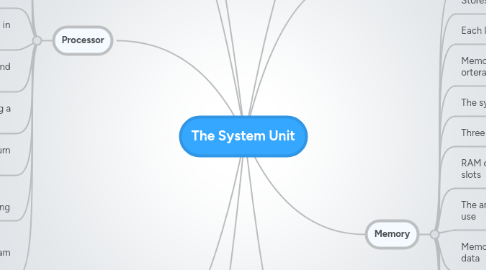The System Unit
por มนตรี อังคปิยะศิริ


1. Processor
1.1. The processor, also called the central processing unit (CPU), interprets and carries out the basic instructions that operate a computer
1.2. The control unitis the component of the processor that directs and coordinates most of the operations in the computer
1.3. The arithmetic logic unit(ALU) performs arithmetic, comparison, and other operations
1.4. For every instruction, a processor repeats a set of four basic operations, which comprise a machine cycle
1.5. Most current personal computers support pipelining
1.6. The pace of the system clock is called the clock speed, and is measured in gigahertz(GHz)
1.7. The leading manufacturers of personal computer processor chips are Intel and AMD
1.8. Determine how you plan to use a new computer before selecting a processor
1.9. A processor chip generates heat that could cause the chip to burn up
1.10. Require additional cooling
1.10.1. –Heat sinks
1.10.2. –Liquid cooling technology
1.11. Parallel processing uses multiple processors simultaneously to execute a single program or task
1.11.1. Massively parallel processing involves hundreds or thousands of processors
2. Data Representation
2.1. Most computers are digital
2.2. The binary systemuses two unique digits (0 and 1)•Bitsand bytes
2.3. A computer circuit represents the 0 or the 1 electronically by the presence or absence of an electrical charge Eight bits grouped together as a unit are called a byte. A byte represents a single character in the computer
2.4. ASCII (American Standard Code for Information Interchange) is the most widely used coding scheme to represent data
3. Ports and Connectors
3.1. A portis the point at which a peripheral attaches to or communicates with a system unit (sometimes referred to as a jack)
3.2. A connectorjoins a cable to a port
3.3. On a notebook computer, the ports are on the back, front, and/or sides
3.4. A USB portcan connect up to 127 different peripherals together with a single connector
3.4.1. You can attach multiple peripherals using a single USB port with a USB hub
3.5. Other types of ports include
3.6. A Bluetooth wireless port adapter converts a USB port into a Bluetooth port
3.7. A smart phone might communicate with a notebook computer using an IrDA port
3.8. A port replicator is an external device that provides connections to peripherals through ports built into the device
3.9. A docking station is an external device that attaches to a mobile computer or device
4. Keeping Your Computer or Mobile Device Clean
4.1. Clean your computer or mobile device once or twice a year
4.2. Turn off and unplug your computer or mobile device before cleaning it
4.3. Use compressed air to blow away dust
4.4. Use an antistatic wipe to clean the exterior of the case and a cleaning solution and soft cloth to clean the screen
5. Summary
5.1. Components of the system unit
5.2. How memory stores data, instructions, and information
5.3. Sequence of operations that occur when a computer executes an instruction
5.4. Comparison of various personal computer processors on the market today
5.5. How to clean the exterior and interior of a system unit
6. Power Supply
6.1. The power supplyconverts the wall outlet AC power into DC powerSome external peripherals have an AC adapter, which is an external power supply
7. Memory
7.1. Memoryconsists of electronic components that store instructions waiting to be executed by the processor, data needed by those instructions, and the results of processing the data
7.2. Stores three basic categories of items
7.3. Each location in memory has an address
7.4. Memory size is measured in kilobytes(KBor K), megabytes(MB), gigabytes(GB), orterabytes(TB)
7.5. The system unit contains two types of memory
7.6. Three basic types of RAM chips exist
7.7. RAM chips usually reside on a memory moduleand are inserted into memory slots
7.8. The amount of RAM necessary in a computer often depends on the types of software you plan to use
7.9. Memory cache speeds the processes of the computer because it stores frequently used instructions and data
7.10. Flash memorycan be erased electronically and rewritten
7.10.1. CMOStechnology provides high speeds and consumes little power
7.11. Access timeis the amount of time it takes the processor to read from memory
7.11.1. Access timeis the amount of time it takes the processor to read from memory
7.12. An expansion slotis a socket on the motherboard that can hold an adapter card
7.13. An adapter cardenhances functions of a component of the system unit and/or provides connections to peripherals
7.13.1. Sound card andvideo card
7.14. With Plug and Play, the computer automatically can configure adapter cards and other peripherals as you install them
7.15. Removable flash memory includes
7.15.1. Memory cards, USB flash drives, and PC Cards/ExpressCardmodules
8. Buses
8.1. A busallows the various devices both inside and attached to the system unit to communicate with each other
8.1.1. Data bus
8.1.2. Address bus
8.2. Word sizeis the number of bits the processor can interpret and execute at a given time
8.3. Expansion slots connect to expansion buses
8.4. Common types of expansion buses include
8.4.1. PCI bus
8.4.2. PCI Express bus
8.4.3. Accelerated Graphics Port
8.4.4. Graphics PortUSB and FireWire bus
8.4.5. PC Card bus
8.5. A bayis an opening inside the system unit in which you can install additional equipment
8.5.1. A drive baytypically holds disk drives
